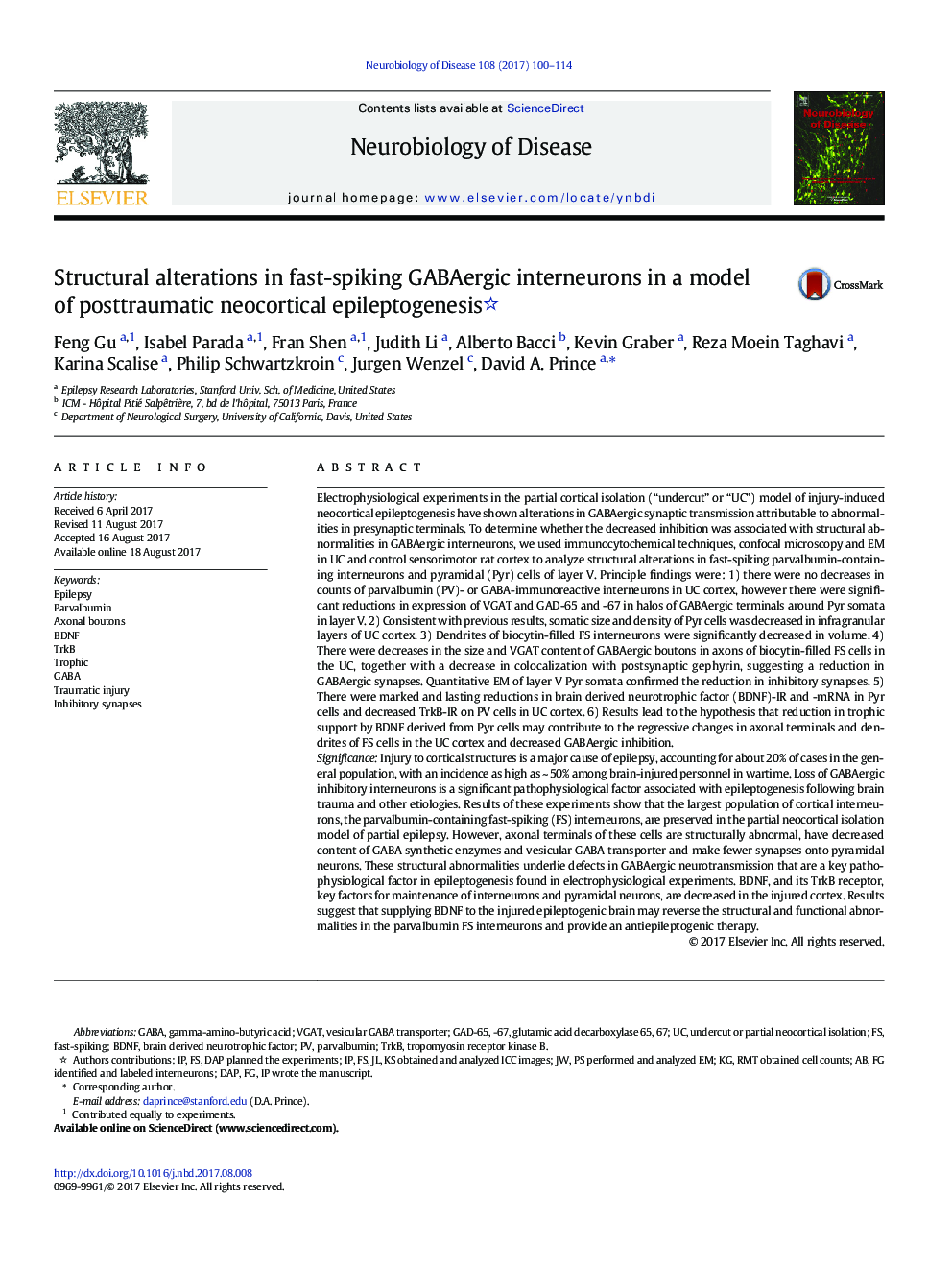| کد مقاله | کد نشریه | سال انتشار | مقاله انگلیسی | نسخه تمام متن |
|---|---|---|---|---|
| 5630529 | 1580613 | 2017 | 15 صفحه PDF | دانلود رایگان |

- Numbers and size of pyramidal (Pyr) cells decrease in partially isolated (UC) neocortex without reduction in GABAergic interneurons.
- Structural alterations in terminals of parvalbumin (PV) interneurons in UC are consistent with known presynaptic abnormalities in GABAergic inhibition.
- Quantitative EM and immunocytochemical results show a reduction in inhibitory synapses on layer V Pyr somata in UC.
- Deafferentaion and injury result in decreases in BDNF protein and mRNA in UC Pyr cells and reductions in TrkB-IR on PV cell somata.
- We hypothesize that decreases in trophic support contribute to structural and functional abnormalities of PV interneurons and disinhibition.
Electrophysiological experiments in the partial cortical isolation (“undercut” or “UC”) model of injury-induced neocortical epileptogenesis have shown alterations in GABAergic synaptic transmission attributable to abnormalities in presynaptic terminals. To determine whether the decreased inhibition was associated with structural abnormalities in GABAergic interneurons, we used immunocytochemical techniques, confocal microscopy and EM in UC and control sensorimotor rat cortex to analyze structural alterations in fast-spiking parvalbumin-containing interneurons and pyramidal (Pyr) cells of layer V. Principle findings were: 1) there were no decreases in counts of parvalbumin (PV)- or GABA-immunoreactive interneurons in UC cortex, however there were significant reductions in expression of VGAT and GAD-65 and -67 in halos of GABAergic terminals around Pyr somata in layer V. 2) Consistent with previous results, somatic size and density of Pyr cells was decreased in infragranular layers of UC cortex. 3) Dendrites of biocytin-filled FS interneurons were significantly decreased in volume. 4) There were decreases in the size and VGAT content of GABAergic boutons in axons of biocytin-filled FS cells in the UC, together with a decrease in colocalization with postsynaptic gephyrin, suggesting a reduction in GABAergic synapses. Quantitative EM of layer V Pyr somata confirmed the reduction in inhibitory synapses. 5) There were marked and lasting reductions in brain derived neurotrophic factor (BDNF)-IR and -mRNA in Pyr cells and decreased TrkB-IR on PV cells in UC cortex. 6) Results lead to the hypothesis that reduction in trophic support by BDNF derived from Pyr cells may contribute to the regressive changes in axonal terminals and dendrites of FS cells in the UC cortex and decreased GABAergic inhibition.SignificanceInjury to cortical structures is a major cause of epilepsy, accounting for about 20% of cases in the general population, with an incidence as high as ~Â 50% among brain-injured personnel in wartime. Loss of GABAergic inhibitory interneurons is a significant pathophysiological factor associated with epileptogenesis following brain trauma and other etiologies. Results of these experiments show that the largest population of cortical interneurons, the parvalbumin-containing fast-spiking (FS) interneurons, are preserved in the partial neocortical isolation model of partial epilepsy. However, axonal terminals of these cells are structurally abnormal, have decreased content of GABA synthetic enzymes and vesicular GABA transporter and make fewer synapses onto pyramidal neurons. These structural abnormalities underlie defects in GABAergic neurotransmission that are a key pathophysiological factor in epileptogenesis found in electrophysiological experiments. BDNF, and its TrkB receptor, key factors for maintenance of interneurons and pyramidal neurons, are decreased in the injured cortex. Results suggest that supplying BDNF to the injured epileptogenic brain may reverse the structural and functional abnormalities in the parvalbumin FS interneurons and provide an antiepileptogenic therapy.
Journal: Neurobiology of Disease - Volume 108, December 2017, Pages 100-114